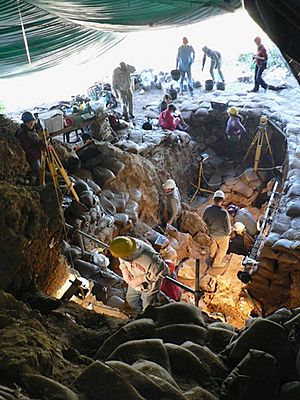Pinnacle Point facts for kids
Quick facts for kids Pinnacle Point |
|
|---|---|
| Location | Mossel Bay, Western Cape Province |
Pinnacle Point is a very important place near Mossel Bay in South Africa. It's a small piece of land that sticks out into the ocean. Since the year 2000, scientists have been digging in caves here. They found proof that people from the Middle Stone Age lived here a very long time ago. This was between 170,000 and 40,000 years ago.
One important cave is called Cave 13B (PP13B). Here, scientists found the earliest signs that people regularly ate seafood like shellfish. They also found signs of "symbolic behaviour," which means using things like art or special colors. Another cave, Pinnacle Point Cave 5–6 (PP5–6), showed the oldest proof that people heated rocks. They did this to make better stone tools. The only human bones found at Pinnacle Point are from PP13B and are about 100,000 years old.
Contents
Discovering Pinnacle Point's Past
The amazing discoveries at Pinnacle Point were made by a team of scientists from many countries. This team is led by palaeoanthropologist Curtis Marean. A palaeoanthropologist is a scientist who studies ancient humans and their ancestors. Marean is from Arizona State University. Other researchers are from South Africa, Australia, Israel, and France.
For many years, scientists have discussed how and when modern humans appeared. Now, most agree that Homo sapiens (that's us!) first appeared in Africa. This happened about 200,000 to 160,000 years ago. At that time, the Earth was in an ice age, and much of Africa was very dry.
Finding old human sites from that time is rare in Africa. Curtis Marean studied land formations, ocean currents, and climate information. He used this to guess where ancient people might have lived. Pinnacle Point was one of the places he found.
Early Human Life at Pinnacle Point
At Cave 13B (PP13B), scientists found evidence of early human symbolic behaviour. This includes scraped and ground ochre, which is a type of colored earth. People might have used this ochre to make pigments for body painting. This is similar to how people used ochre at Blombos Cave, another important site. These discoveries show that early humans might have had complex behaviors much earlier than once thought. This challenges the idea that "modern behaviour" appeared suddenly around 40,000 years ago.
The climate was harsh during the ice age, and food was scarce. This might be why people moved to the coast at Pinnacle Point. Here, they could find food like shellfish, whales, and seals.
Scientists also found many plant remains from trees in PP13B. These remains are about 90,000 years old. This suggests that people might have burned wood in their fires.
Protecting a Special Place
In December 2012, a group called Heritage Western Cape declared Pinnacle Point a provincial heritage site. This means it is a very important place in South Africa's history. This declaration gives the site the strongest protection under South African law.
In 2015, the South African government suggested that Pinnacle Point should become a World Heritage Site. These are places recognized by UNESCO as being very important to all of humanity. Pinnacle Point is now on a list of possible future World Heritage Sites. It might join other important caves like Blombos Cave, Sibudu Cave, Klasies River Caves, Border Cave, and Diepkloof Rock Shelter.
See also
 In Spanish: Yacimiento arqueológico de Pinnacle Point para niños
In Spanish: Yacimiento arqueológico de Pinnacle Point para niños


